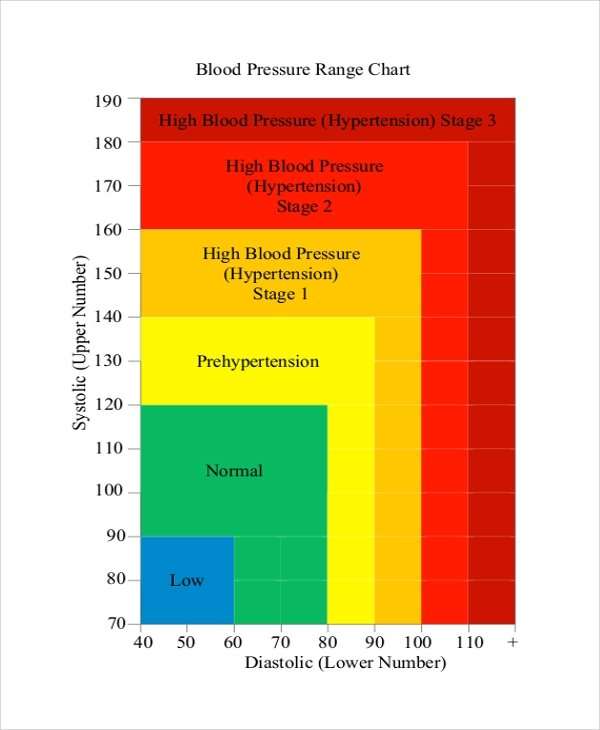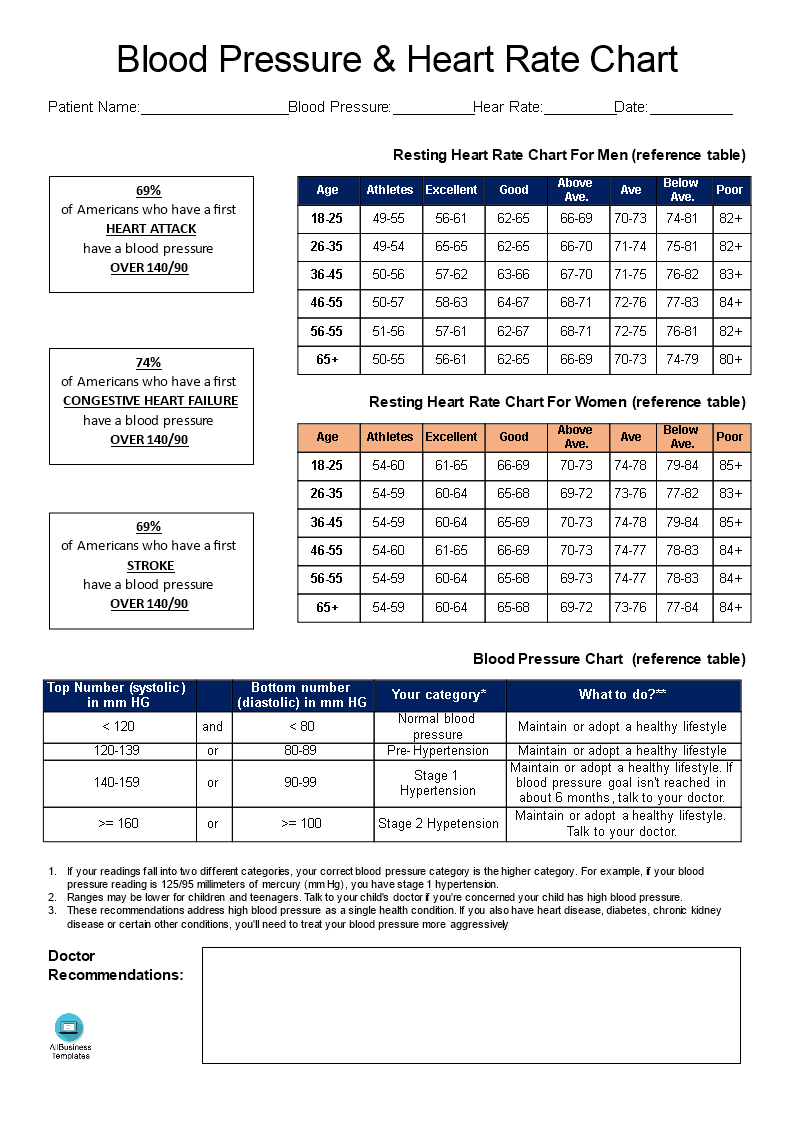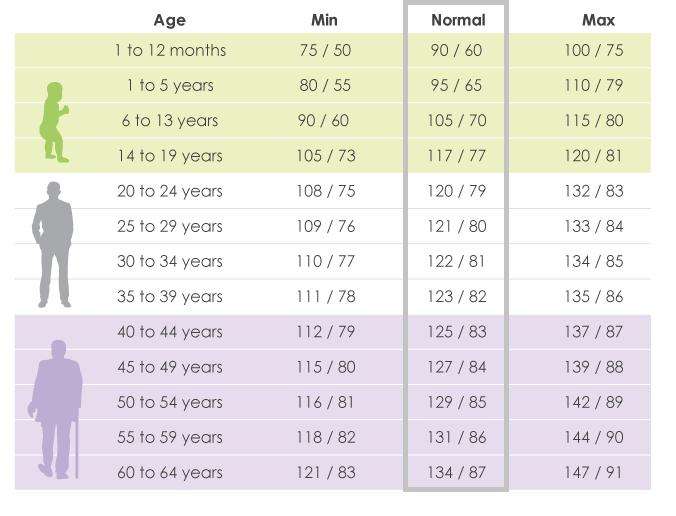Normal Blood Pressure Range
A normal blood pressure reading indicates that the heart and blood vessels are not working too hard pushing blood and that the blood is not exerting too much pressure on the walls of the vessels, says Aseem Desai, M.D., a cardiologist at Providence Mission Hospital in Southern California. Recent data from the American Heart Association suggests the optimal normal reading for adults over 20 is lower than 120/80 mmHgVirani S, et al. Heart disease and stroke statistics 2021 update . American Heart Association Journal. 2021 143:e254-e743. .
Dr. Desai notes blood pressure can vary depending on a persons age, gender, race and ethnicity, but it should still fall within the general normal range. While numbers lower than 120/80 are generally considered normal, Dr. Desai adds, The target blood pressure for treatment varies depending on age and associated co-morbidities .
Previously, guidance for normal blood pressure for adults varied by gender and specific age, but new data states normal blood pressure for adults as a collective is less than 120/80 mmHgHigh Blood Pressure Symptoms and Causes. Centers for Disease Control and Prevention. Accessed 7/16/2021. .
When it comes to race and ethnicity, Dr. Desai says certain groups have a higher rate of hypertension. Non-Hispanic Black people have a significantly higher rate of hypertension compared to non-Hispanic white people, and Hispanics and non-Hispanic Asians have lower rates than the first two, he says.
What Is Normal Blood Pressure
For years we have been told that a normal blood pressure reading is 120/80 however, more and more doctors have now lowered these numbers to 115/75. Blood pressure is different for everyone as many factors can have an effect on the numbers.
Our blood pressure refers to the amount of force behind the blood as it hits the arterial walls. As the heart pumps the blood, an ideal pressure sees the blood push against the walls that are flexible enough to expand and retract easily. Over time, our age, diet, and physical activity play a role on the elasticity of our blood vessels. With a loss of flexibility due to hardening of the walls, the heart needs to work harder to push the blood.
These factors determine the blood pressure numbers. The systolic number is the top number, and it indicates the pressure as the heart beats or pushes the blood throughout the body. The diastolic number is the bottom number, and refers to the pressure in the arteries when the heart rests between beats. During this time, the heart receives oxygen as it fills with blood.
Treating High Blood Pressure
Treating high blood pressure includes lifestyle changes and prescription medication for those with readings of 140/90 or higher, according to the AHA.
“The first thing we tell people to do if their blood pressure is in prehypertension range, is to lose weight, exercise more, and reduce salt in diet,” Bauman said. “If they reach higher levels, we then treat them with medications.”
Additional reporting by Kim Ann Zimmermann, Live Science Contributor.
Don’t Miss: Does Claritin D Cause High Blood Pressure
What Do Blood Pressure Numbers Mean
Blood pressure readings are composed of two numbersfor example, 120/80 mm Hg.
The top number measures the pressure in your arteries when your heart beats. The bottom number measures the pressure in your arteries between each heart beat.
The standard unit of measure, mm Hg, stands for “millimeters of mercury.” Mercury pressure gauges have been replaced with electronic pressure gauges, but the abbreviation is still used.
The Difference Between Blood Pressure And Pulse

Blood pressure refers to the force of blood against the artery walls, whereas a persons pulse indicates the number of times the heart beats per minute.
A resting heart rate is when a person is sitting, lying down, or not engaged in an activity.
An active heart rate is when a person is exercising or engaged in physical activity.
Everyone has a slightly different resting heart rate, but the is between 60 and 100 beats per minute. A physically active person may have a heart rate as low as 40 beats per minute.
Similarly to blood pressure, a persons heart rate or pulse indicates how healthy the heart is.
of blood pressure:
Don’t Miss: Low Blood Pressure Heart Attack
How To Take Blood Pressure
You can take your blood pressure at home using a wrist blood pressure monitor or an upper arm cuff blood pressure monitor. Experts typically recommend upper arm cuffs because they are the most accurate. Upper arm cuffs can come with either a manual or digital monitor. Both work well, but if youre measuring your blood pressure on your own regularly, a digital one will likely be easiest to use correctly.
To take your blood pressure accurately with a digital upper arm cuff, start by sitting quietly in an upright position for a few minutes, allowing your body a moment to relax. Be mindful to uncross your legs and ankles, as well as use comfortable support for your back.
With the monitor sitting on a table in front of you, place your arm next to itat approximately heart leveland place the cuff around your bare upper arm about one inch above your elbow. Secure the cuff so that you can only slide a fingertip under the top edge.
Next, simply turn on the monitor, press the start button, and take normal breaths as the cuff inflates and deflates, measuring your blood pressure and producing your reading on the screen.
What Is A Dangerous Heart Rate What Causes High Pulse Rate
Although age and activity level can affect your heart rate, there are some normal parameters.
As an explanation, your resting heart rate is when your heart pumps the minimum amount of blood that your body needs because it is at rest.
A persons heart rate can become dangerous if it is too high or too low. However, many factors can affect when a heart rate is dangerous.
The heart rate changes throughout the day to adapt to the demands of the body. It is highest during times of intense activity and lowest when a person relaxes or sleeps.
The heart rate also changes during pregnancy, fever, and times of anxiety.
Identifying a persons usual heart rate pattern can help her understand what a dangerous heart rate is for her personally.
Contents
Also Check: Reduce Blood Pressure Medication
Heart Attack And Heart Disease
High blood pressure can damage your arteries by making them less elastic, which decreases the flow of blood and oxygen to your heart and leads to heart disease. In addition, decreased blood flow to the heart can cause:
- Chest pain, also called angina.
- Heart attack, which happens when the blood supply to your heart is blocked and heart muscle begins to die without enough oxygen. The longer the blood flow is blocked, the greater the damage to the heart.
- Heart failure, a condition that means your heart cant pump enough blood and oxygen to your other organs.
What Things Affect Heart Rate
Other than exercise, things that can affect your heart rate include:
- Weather. Your pulse may go up a bit in higher temperatures and humidity levels.
- Standing up. It might spike for about 20 seconds after you first stand up from sitting.
- Emotions. Stress and anxiety can raise your heart rate. It may also go up when youâre very happy or sad.
- Body size. People who have severe obesity can have a slightly faster pulse.
- Medications. Beta-blockers slow your heart rate. Too much thyroid medicine can speed it up.
- Caffeine and nicotine. Coffee, tea, and soda raise your heart rate. So does tobacco.
Also Check: Can Pain Lower Blood Pressure
Chart: What Are Normal Blood Pressure Ranges By Age For Women
As with men, women’s average BP ranges also vary by age group. The age group with the lowest normal blood pressure reading is different between the systolic and diastolic reading. Women ages 21-25 have the lowest normal diastolic reading , while women age 31-35 have the lowest normal systolic reading . The age group with the highest normal blood pressure reading is women ages 56-60 .
High Blood Pressure Categories
You can divide high blood pressure into five categories, according to guidelines from the American College of Cardiology:
- Normal: Normal blood pressure in adults is any blood pressure below 120/80.
- Elevated: In adults, elevated blood pressure is a systolic reading of 120-129 and a diastolic reading below 80.
- Hypertension stage I: This stage includes blood pressures ranges of 130-139 or 80-89 .
- Hypertension stage II: This stage includes blood pressures ranges above 140 or above 90 .
- Hypertensive crisis: Severely elevated blood pressure is defined as greater than 180 and/or 120 and associated with new or worsening organ damage.
You May Like: Symptom Of High Blood Pressure
Average Blood Pressure By Age
As you get older, your blood vessels tend to become stiffer and plaque can build up in them, which can raise your blood pressure. If your blood pressure becomes too high, you’re at a greater risk for heart disease, strokes, and more.
In 2015, the average blood pressure worldwide was 127/79 mm Hg in men, and 122/77 mm Hg in women, according to a study analysis published in Lancet.
When researchers for the National Center for Health Statistics looked at average blood pressure in U.S. adults between 2001 and 2008, the average reading was 122/71 mm Hg. The breakout was 124/72 mm Hg for men, and 121/70 mm Hg in women. It rose by age and was significantly higher in Black people.
The researchers found the following breakdown by age, sex, and race or ethnicity:
| Blood Pressure by Age |
|---|
As the population ages and life expectancy increases, high blood pressure is becoming more common.
What Are The Symptoms Of High Blood Pressure

The only way you can know for sure if you have high blood pressure is by having a nurse or doctor measure it. Monitoring your blood pressure at home also helps keep your blood pressure in check. Most often, high blood pressure is “silent,” meaning it has no other signs to warn you, according to the CDC.
You May Like: What Animal Has The Highest Blood Pressure
High Blood Pressure Symptoms
High blood pressure is known as the silent killer because it typically has no symptoms. In fact, most people dont even realize they have hypertension until their blood pressure is monitored.
Symptoms dont develop until the numbers get very high and organs get damaged, often irreversibly, says Dr. Desai.
If you have severe hypertension, you might notice the below symptoms, some of which were reported by patients in a study in the British Journal of General PracticeGoodhart A. Hypertension from the patients perspective. British Journal of General Practice. 2016 66:570. :
- Headaches
Heart Rate Vs Blood Pressure: What You Need To Know
Your heart rate and blood pressure measure two different things, but doctors can use both of them to evaluate certain aspects of your health. The heart rate records the number of times that your heart beats per minute, while your blood pressure quantifies how strong your blood moves through the blood vessels.
Does Your Heart Rate Affect Your Blood Pressure?
Your heart rate and your blood pressure do not automatically increase at the same rate. Its possible for your heart rate to safely increase twice as much as the normal heart rate while your blood pressure only increases a minimal amount. In fact, even when your heart beats above the normal number of times per minute, healthy blood vessels can become larger for easier blood flow. For instance, your heart rate increases when you exercise which helps more blood to reach your muscles.
Aside from physical activities, your heart rate may also be affected by air temperature, your emotions, your body position, your body size and use of medications.
How Can You Measure Your Heart Rate?
You can easily check your heart rate, whether youre exercising or doing your normal chores, by wearing an activity tracker. But if you dont use one, you can also measure it manually by doing the following:
You may also find a pulse and measure your heart ra
te on the side of your neck, the inside of your elbow or the top of your foot.
What Is Your Target and Maximum Heart Rate?
| Age |
You May Like: Bp And Headaches
Measuring Your Blood Pressure
Healthcare professionals use a stethoscope and a manual sphygmomanometer to measure your blood pressure. Typically they take the reading above your elbow. The sphygmomanometer has a bladder, cuff, bulb, and a gauge. When the bulb is pumped it inflates the bladder inside the cuff, which is wrapped around your arm. This inflation will stop the blood flow in your arteries.
The stethoscope is used to listen for sound of the heartbeat, and no sound indicates that there is no flow. As the pressure is released from the bladder, you will hear the sound of the blood flowing again. That point becomes your blood pressure systolic reading. The diastolic reading is when you hear no sound again, which means that the blood flow is back to normal.
Blood Pressure And Heart Rate Have Normal Target Numbers
False: There are guidelines, but whats normal varies from person to person.
Optimal blood pressure typically is defined as 120 mm Hg systolic which is the pressure as your heart beats over 80 mm Hg diastolic which is the pressure as your heart relaxes. For your resting heart rate, the target is between 60 and 100 beats per minute .
Keep in mind that heart rate and blood pressure are a customized fit. You need to work with your doctor to establish a baseline thats normal for you.
Recommended Reading: What Can U Take For High Blood Pressure
Normal Blood Pressure For Children
Normal BP ranges vary in children by age. The University of Iowa Stead Family Childrens Hospital provides this chart:
| Normal Blood Pressure for Children | |
|---|---|
| Systolic | |
| 112128 mm Hg | 6680 mm Hg |
What is considered healthy for your child also varies by height, age, and sex. You can use Baylor College of Medicine’s calculator to see if your childs blood pressure reading is in a healthy range.
Side Effects Of Low Blood Pressure
Low blood pressure may not be discussed as often as high blood pressure, but it should be addressed, as prolonged low blood pressure can negatively affect your organs.
A certain amount of blood pressure is needed to maintain blood flow to the organs, says Dr. Wong. The blood supplies oxygen and nutrients to these organs. If the blood pressure is too low, an adequate blood supply cannot get to these organs.
If left untreated, low blood pressure can increase your risk of fainting, heart attack and organ damage, adds Dr. Desai.
Don’t Miss: Mayo Clinic High Blood Pressure Diet
Be Still My Heart: How A Heart Rhythm Specialist Can Help
When this happens, electrophysiologists first try and slow theheart rate using medicines, Dr. Taigen says. But these medicines, known asbeta-blockers or calcium channel blockers, can also drop the blood pressure,he notes. Quite often, theres not much room for blood pressure to go lower.
If your blood pressure is too low for medications, aprocedure called direct current cardioversion can get the rhythm back tonormal.
With this procedure, we put pads on the front and back of the chest and sedate the patient for a minute or two, Dr. Taigen explains. When they are asleep, we deliver a shock that stops the heart from beating irregularly, so the natural heartbeat resumes.Once the heart rhythm is back to normal, anelectrophysiologist determines if a more permanent treatment is needed. Thesecould include:
- Ablation: This procedure uses cold orheat energy to stop faulty electrical signals.
- Pacemaker: Doctors place a small deviceunder the skin to send electrical impulses that change the heart rhythm.
- Implantable cardioverter defibrillator :Like a pacemaker, the ICD works by detecting and stopping faulty heart rhythmswith electrical signals.
- Surgery: Surgeons create scar tissue withincisions to permanently interrupt faulty electrical pathways in the heart.
What Are The Symptoms Of High Blood Pressure In Women

High blood pressure, also known as HBP or hypertension, is widely misunderstood and is called the silent killer because there can often be no symptoms. We often assume it affects those who are type-A personalities, tense and aggressive. But the truth is, it has nothing to do with personality traits. In fact, you can be the most relaxed, calm person and still suffer from HBP.
Don’t Miss: Pain Increase Blood Pressure
Checking Your Blood Pressure Vs Heart Rate
Your resting heart rate indicates how hard your heart is working in its normal state. When you exert yourself, your heart rate increases. You can easily check your heart rate by finding your pulse in your neck or wrist and counting the number of heartbeats per one minute.
Your blood pressure is more complicated to check, as youll need a blood pressure cuff. Some drug stores and supermarkets have machines you can use to check your blood pressure or you can buy one. Otherwise, you can get it checked at your doctors office.
Its common to have some variation in your individual blood pressure readings. If a reading is borderline high, your doctor may have you repeat it on another day or watch it the next time you go to the doctors office. Your pulse can change as well, depending on your exertion and stress levels.
When youre looking at your overall health, its important to know the difference between your pulse and blood pressure numbers and what they signify. If you think your numbers are abnormal, talk to your doctor. If you dont have a doctor, find one at UPMC.